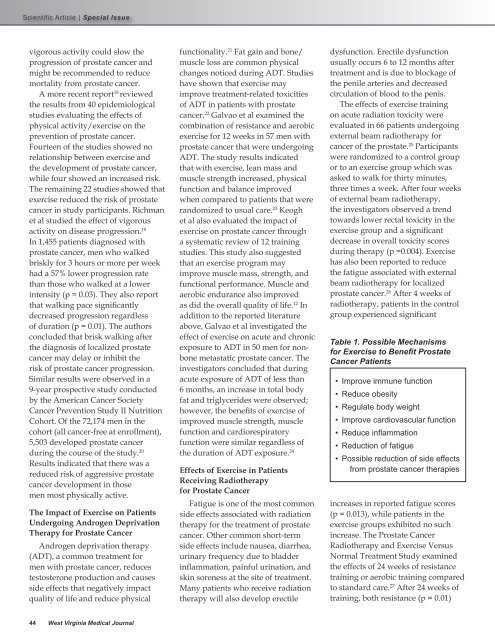Special CME Issue - West Virginia State Medical Association
Special CME Issue - West Virginia State Medical Association
Special CME Issue - West Virginia State Medical Association
You also want an ePaper? Increase the reach of your titles
YUMPU automatically turns print PDFs into web optimized ePapers that Google loves.
vigorous activity could slow the<br />
progression of prostate cancer and<br />
might be recommended to reduce<br />
mortality from prostate cancer.<br />
A more recent report 18 reviewed<br />
the results from 40 epidemiological<br />
studies evaluating the effects of<br />
physical activity/exercise on the<br />
prevention of prostate cancer.<br />
Fourteen of the studies showed no<br />
relationship between exercise and<br />
the development of prostate cancer,<br />
while four showed an increased risk.<br />
The remaining 22 studies showed that<br />
exercise reduced the risk of prostate<br />
cancer in study participants. Richman<br />
et al studied the effect of vigorous<br />
activity on disease progression. 19<br />
In 1,455 patients diagnosed with<br />
prostate cancer, men who walked<br />
briskly for 3 hours or more per week<br />
had a 57% lower progression rate<br />
than those who walked at a lower<br />
intensity (p = 0.03). They also report<br />
that walking pace significantly<br />
decreased progression regardless<br />
of duration (p = 0.01). The authors<br />
concluded that brisk walking after<br />
the diagnosis of localized prostate<br />
cancer may delay or inhibit the<br />
risk of prostate cancer progression.<br />
Similar results were observed in a<br />
9-year prospective study conducted<br />
by the American Cancer Society<br />
Cancer Prevention Study II Nutrition<br />
Cohort. Of the 72,174 men in the<br />
cohort (all cancer-free at enrollment),<br />
5,503 developed prostate cancer<br />
during the course of the study. 20<br />
Results indicated that there was a<br />
reduced risk of aggressive prostate<br />
cancer development in those<br />
men most physically active.<br />
The Impact of Exercise on Patients<br />
Undergoing Androgen Deprivation<br />
Therapy for Prostate Cancer<br />
Androgen deprivation therapy<br />
(ADT), a common treatment for<br />
men with prostate cancer, reduces<br />
testosterone production and causes<br />
side effects that negatively impact<br />
quality of life and reduce physical<br />
functionality. 21 Fat gain and bone/<br />
muscle loss are common physical<br />
changes noticed during ADT. Studies<br />
have shown that exercise may<br />
improve treatment-related toxicities<br />
of ADT in patients with prostate<br />
cancer. 22 Galvao et al examined the<br />
combination of resistance and aerobic<br />
exercise for 12 weeks in 57 men with<br />
prostate cancer that were undergoing<br />
ADT. The study results indicated<br />
that with exercise, lean mass and<br />
muscle strength increased, physical<br />
function and balance improved<br />
when compared to patients that were<br />
randomized to usual care. 23 Keogh<br />
et al also evaluated the impact of<br />
exercise on prostate cancer through<br />
a systematic review of 12 training<br />
studies. This study also suggested<br />
that an exercise program may<br />
improve muscle mass, strength, and<br />
functional performance. Muscle and<br />
aerobic endurance also improved<br />
as did the overall quality of life. 12 In<br />
addition to the reported literature<br />
above, Galvao et al investigated the<br />
effect of exercise on acute and chronic<br />
exposure to ADT in 50 men for nonbone<br />
metastatic prostate cancer. The<br />
investigators concluded that during<br />
acute exposure of ADT of less than<br />
6 months, an increase in total body<br />
fat and triglycerides were observed;<br />
however, the benefits of exercise of<br />
improved muscle strength, muscle<br />
function and cardiorespiratory<br />
function were similar regardless of<br />
the duration of ADT exposure. 24<br />
Effects of Exercise in Patients<br />
Receiving Radiotherapy<br />
for Prostate Cancer<br />
Fatigue is one of the most common<br />
side effects associated with radiation<br />
therapy for the treatment of prostate<br />
cancer. Other common short-term<br />
side effects include nausea, diarrhea,<br />
urinary frequency due to bladder<br />
inflammation, painful urination, and<br />
skin soreness at the site of treatment.<br />
Many patients who receive radiation<br />
therapy will also develop erectile<br />
dysfunction. Erectile dysfunction<br />
usually occurs 6 to 12 months after<br />
treatment and is due to blockage of<br />
the penile arteries and decreased<br />
circulation of blood to the penis.<br />
The effects of exercise training<br />
on acute radiation toxicity were<br />
evaluated in 66 patients undergoing<br />
external beam radiotherapy for<br />
cancer of the prostate. 25 Participants<br />
were randomized to a control group<br />
or to an exercise group which was<br />
asked to walk for thirty minutes,<br />
three times a week. After four weeks<br />
of external beam radiotherapy,<br />
the investigators observed a trend<br />
towards lower rectal toxicity in the<br />
exercise group and a significant<br />
decrease in overall toxicity scores<br />
during therapy (p =0.004). Exercise<br />
has also been reported to reduce<br />
the fatigue associated with external<br />
beam radiotherapy for localized<br />
prostate cancer. 26 After 4 weeks of<br />
radiotherapy, patients in the control<br />
group experienced significant<br />
Table 1. Possible Mechanisms<br />
for Exercise to Benefit Prostate<br />
Cancer Patients<br />
• Improve immune function<br />
• Reduce obesity<br />
• Regulate body weight<br />
• Improve cardiovascular function<br />
• Reduce inflammation<br />
• Reduction of fatigue<br />
• Possible reduction of side effects<br />
from prostate cancer therapies<br />
increases in reported fatigue scores<br />
(p = 0.013), while patients in the<br />
exercise groups exhibited no such<br />
increase. The Prostate Cancer<br />
Radiotherapy and Exercise Versus<br />
Normal Treatment Study examined<br />
the effects of 24 weeks of resistance<br />
training or aerobic training compared<br />
to standard care. 27 After 24 weeks of<br />
training, both resistance (p = 0.01)<br />
44 <strong>West</strong> <strong>Virginia</strong> <strong>Medical</strong> Journal















